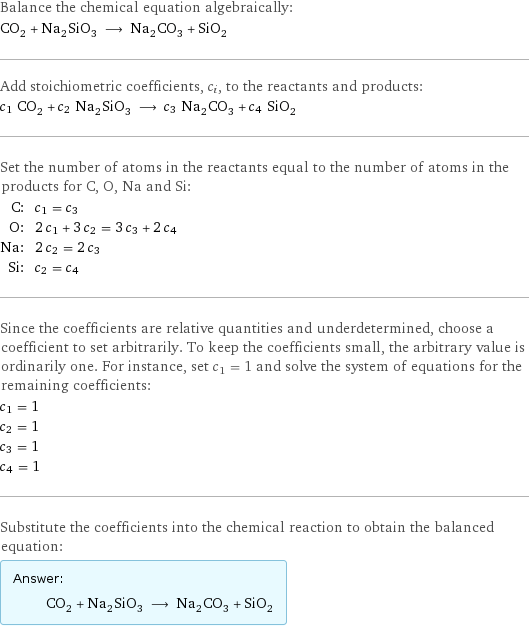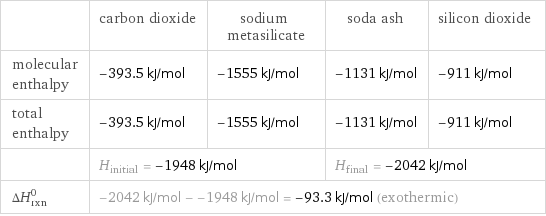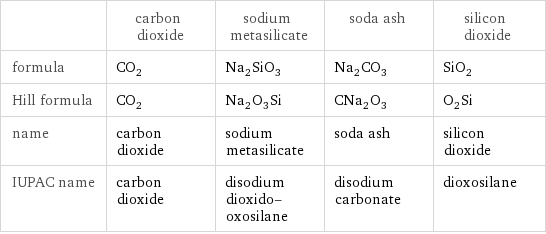Input interpretation

CO_2 carbon dioxide + Na_2SiO_3 sodium metasilicate ⟶ Na_2CO_3 soda ash + SiO_2 silicon dioxide
Balanced equation

Balance the chemical equation algebraically: CO_2 + Na_2SiO_3 ⟶ Na_2CO_3 + SiO_2 Add stoichiometric coefficients, c_i, to the reactants and products: c_1 CO_2 + c_2 Na_2SiO_3 ⟶ c_3 Na_2CO_3 + c_4 SiO_2 Set the number of atoms in the reactants equal to the number of atoms in the products for C, O, Na and Si: C: | c_1 = c_3 O: | 2 c_1 + 3 c_2 = 3 c_3 + 2 c_4 Na: | 2 c_2 = 2 c_3 Si: | c_2 = c_4 Since the coefficients are relative quantities and underdetermined, choose a coefficient to set arbitrarily. To keep the coefficients small, the arbitrary value is ordinarily one. For instance, set c_1 = 1 and solve the system of equations for the remaining coefficients: c_1 = 1 c_2 = 1 c_3 = 1 c_4 = 1 Substitute the coefficients into the chemical reaction to obtain the balanced equation: Answer: | | CO_2 + Na_2SiO_3 ⟶ Na_2CO_3 + SiO_2
Structures

+ ⟶ +
Names

carbon dioxide + sodium metasilicate ⟶ soda ash + silicon dioxide
Reaction thermodynamics
Enthalpy

| carbon dioxide | sodium metasilicate | soda ash | silicon dioxide molecular enthalpy | -393.5 kJ/mol | -1555 kJ/mol | -1131 kJ/mol | -911 kJ/mol total enthalpy | -393.5 kJ/mol | -1555 kJ/mol | -1131 kJ/mol | -911 kJ/mol | H_initial = -1948 kJ/mol | | H_final = -2042 kJ/mol | ΔH_rxn^0 | -2042 kJ/mol - -1948 kJ/mol = -93.3 kJ/mol (exothermic) | | |
Gibbs free energy

| carbon dioxide | sodium metasilicate | soda ash | silicon dioxide molecular free energy | -394.4 kJ/mol | -14628 kJ/mol | -1044 kJ/mol | -856 kJ/mol total free energy | -394.4 kJ/mol | -14628 kJ/mol | -1044 kJ/mol | -856 kJ/mol | G_initial = -15022 kJ/mol | | G_final = -1900 kJ/mol | ΔG_rxn^0 | -1900 kJ/mol - -15022 kJ/mol = 13122 kJ/mol (endergonic) | | |
Equilibrium constant
![Construct the equilibrium constant, K, expression for: CO_2 + Na_2SiO_3 ⟶ Na_2CO_3 + SiO_2 Plan: • Balance the chemical equation. • Determine the stoichiometric numbers. • Assemble the activity expression for each chemical species. • Use the activity expressions to build the equilibrium constant expression. Write the balanced chemical equation: CO_2 + Na_2SiO_3 ⟶ Na_2CO_3 + SiO_2 Assign stoichiometric numbers, ν_i, using the stoichiometric coefficients, c_i, from the balanced chemical equation in the following manner: ν_i = -c_i for reactants and ν_i = c_i for products: chemical species | c_i | ν_i CO_2 | 1 | -1 Na_2SiO_3 | 1 | -1 Na_2CO_3 | 1 | 1 SiO_2 | 1 | 1 Assemble the activity expressions accounting for the state of matter and ν_i: chemical species | c_i | ν_i | activity expression CO_2 | 1 | -1 | ([CO2])^(-1) Na_2SiO_3 | 1 | -1 | ([Na2SiO3])^(-1) Na_2CO_3 | 1 | 1 | [Na2CO3] SiO_2 | 1 | 1 | [SiO2] The equilibrium constant symbol in the concentration basis is: K_c Mulitply the activity expressions to arrive at the K_c expression: Answer: | | K_c = ([CO2])^(-1) ([Na2SiO3])^(-1) [Na2CO3] [SiO2] = ([Na2CO3] [SiO2])/([CO2] [Na2SiO3])](../image_source/b1f277f57b082c26465a00a61fd8dc54.png)
Construct the equilibrium constant, K, expression for: CO_2 + Na_2SiO_3 ⟶ Na_2CO_3 + SiO_2 Plan: • Balance the chemical equation. • Determine the stoichiometric numbers. • Assemble the activity expression for each chemical species. • Use the activity expressions to build the equilibrium constant expression. Write the balanced chemical equation: CO_2 + Na_2SiO_3 ⟶ Na_2CO_3 + SiO_2 Assign stoichiometric numbers, ν_i, using the stoichiometric coefficients, c_i, from the balanced chemical equation in the following manner: ν_i = -c_i for reactants and ν_i = c_i for products: chemical species | c_i | ν_i CO_2 | 1 | -1 Na_2SiO_3 | 1 | -1 Na_2CO_3 | 1 | 1 SiO_2 | 1 | 1 Assemble the activity expressions accounting for the state of matter and ν_i: chemical species | c_i | ν_i | activity expression CO_2 | 1 | -1 | ([CO2])^(-1) Na_2SiO_3 | 1 | -1 | ([Na2SiO3])^(-1) Na_2CO_3 | 1 | 1 | [Na2CO3] SiO_2 | 1 | 1 | [SiO2] The equilibrium constant symbol in the concentration basis is: K_c Mulitply the activity expressions to arrive at the K_c expression: Answer: | | K_c = ([CO2])^(-1) ([Na2SiO3])^(-1) [Na2CO3] [SiO2] = ([Na2CO3] [SiO2])/([CO2] [Na2SiO3])
Rate of reaction
![Construct the rate of reaction expression for: CO_2 + Na_2SiO_3 ⟶ Na_2CO_3 + SiO_2 Plan: • Balance the chemical equation. • Determine the stoichiometric numbers. • Assemble the rate term for each chemical species. • Write the rate of reaction expression. Write the balanced chemical equation: CO_2 + Na_2SiO_3 ⟶ Na_2CO_3 + SiO_2 Assign stoichiometric numbers, ν_i, using the stoichiometric coefficients, c_i, from the balanced chemical equation in the following manner: ν_i = -c_i for reactants and ν_i = c_i for products: chemical species | c_i | ν_i CO_2 | 1 | -1 Na_2SiO_3 | 1 | -1 Na_2CO_3 | 1 | 1 SiO_2 | 1 | 1 The rate term for each chemical species, B_i, is 1/ν_i(Δ[B_i])/(Δt) where [B_i] is the amount concentration and t is time: chemical species | c_i | ν_i | rate term CO_2 | 1 | -1 | -(Δ[CO2])/(Δt) Na_2SiO_3 | 1 | -1 | -(Δ[Na2SiO3])/(Δt) Na_2CO_3 | 1 | 1 | (Δ[Na2CO3])/(Δt) SiO_2 | 1 | 1 | (Δ[SiO2])/(Δt) (for infinitesimal rate of change, replace Δ with d) Set the rate terms equal to each other to arrive at the rate expression: Answer: | | rate = -(Δ[CO2])/(Δt) = -(Δ[Na2SiO3])/(Δt) = (Δ[Na2CO3])/(Δt) = (Δ[SiO2])/(Δt) (assuming constant volume and no accumulation of intermediates or side products)](../image_source/c49ac2ef3f5e732eb8bc3dba08fafb6c.png)
Construct the rate of reaction expression for: CO_2 + Na_2SiO_3 ⟶ Na_2CO_3 + SiO_2 Plan: • Balance the chemical equation. • Determine the stoichiometric numbers. • Assemble the rate term for each chemical species. • Write the rate of reaction expression. Write the balanced chemical equation: CO_2 + Na_2SiO_3 ⟶ Na_2CO_3 + SiO_2 Assign stoichiometric numbers, ν_i, using the stoichiometric coefficients, c_i, from the balanced chemical equation in the following manner: ν_i = -c_i for reactants and ν_i = c_i for products: chemical species | c_i | ν_i CO_2 | 1 | -1 Na_2SiO_3 | 1 | -1 Na_2CO_3 | 1 | 1 SiO_2 | 1 | 1 The rate term for each chemical species, B_i, is 1/ν_i(Δ[B_i])/(Δt) where [B_i] is the amount concentration and t is time: chemical species | c_i | ν_i | rate term CO_2 | 1 | -1 | -(Δ[CO2])/(Δt) Na_2SiO_3 | 1 | -1 | -(Δ[Na2SiO3])/(Δt) Na_2CO_3 | 1 | 1 | (Δ[Na2CO3])/(Δt) SiO_2 | 1 | 1 | (Δ[SiO2])/(Δt) (for infinitesimal rate of change, replace Δ with d) Set the rate terms equal to each other to arrive at the rate expression: Answer: | | rate = -(Δ[CO2])/(Δt) = -(Δ[Na2SiO3])/(Δt) = (Δ[Na2CO3])/(Δt) = (Δ[SiO2])/(Δt) (assuming constant volume and no accumulation of intermediates or side products)
Chemical names and formulas

| carbon dioxide | sodium metasilicate | soda ash | silicon dioxide formula | CO_2 | Na_2SiO_3 | Na_2CO_3 | SiO_2 Hill formula | CO_2 | Na_2O_3Si | CNa_2O_3 | O_2Si name | carbon dioxide | sodium metasilicate | soda ash | silicon dioxide IUPAC name | carbon dioxide | disodium dioxido-oxosilane | disodium carbonate | dioxosilane
Substance properties

| carbon dioxide | sodium metasilicate | soda ash | silicon dioxide molar mass | 44.009 g/mol | 122.06 g/mol | 105.99 g/mol | 60.083 g/mol phase | gas (at STP) | solid (at STP) | solid (at STP) | solid (at STP) melting point | -56.56 °C (at triple point) | 72.2 °C | 851 °C | 1713 °C boiling point | -78.5 °C (at sublimation point) | | 1600 °C | 2950 °C density | 0.00184212 g/cm^3 (at 20 °C) | 1.749 g/cm^3 | | 2.196 g/cm^3 solubility in water | | soluble | soluble | insoluble dynamic viscosity | 1.491×10^-5 Pa s (at 25 °C) | 1 Pa s (at 1088 °C) | 0.00355 Pa s (at 900 °C) | odor | odorless | | | odorless
Units
